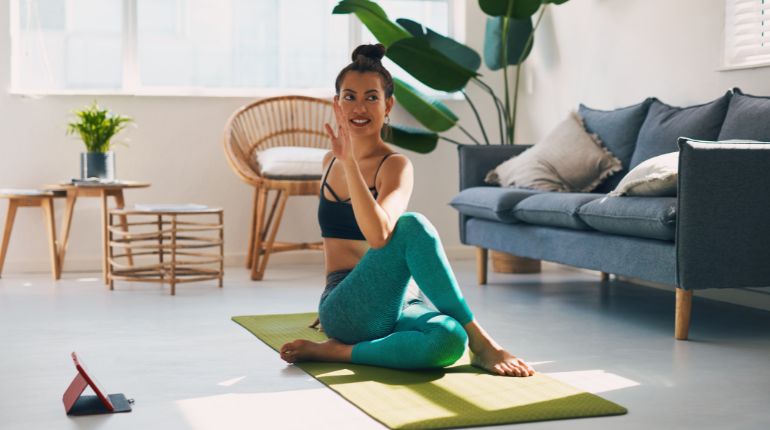Simple Exercises to Improve Flexibility and Strength
Maintaining an active lifestyle is essential for overall health. Strength and flexibility exercises improve mobility, reduce injury risk, and support those with conditions like Parkinson's disease. Simple workouts can enhance balance, reduce stiffness, and improve coordination, helping manage symptoms and improve daily functioning. Incorporating light stretching, walking, or resistance training into your routine can significantly improve mobility and overall well-being.
Following are the simple Exercises to Improve Flexibility and Strength:
Cat-Cow Stretch (Flexibility)
The Cat-Cow stretch is a gentle yoga move that helps increase flexibility in your spine while improving balance and posture. It’s perfect for loosening up your back, especially after sitting for long periods.
How to do it:
With your hands below your shoulders and your knees below your hips, begin on all fours. Taking a deep breath, raise your head and tailbone towards the ceiling while arching your back. Exhale around your back, tucking your chin to your chest and tailbone under (this is Cat). Repeat this movement slowly for 10-15 rounds.
This stretch helps relieve tension and improves spine, neck, and shoulder flexibility.
Lunges (Strength & Flexibility)
Lunges are a great full-body exercise that targets your legs and glutes, improving your hips' overall balance and flexibility.
How to do it:
Stand with your feet hip-width apart. Step forward with your right leg and lower your body until your left knee is just above the floor and the back of your right leg is parallel to it. Push back up to the starting position and switch legs. Repeat 10-12 lunges per leg.
Lunges build strength in your legs and increase flexibility in your hip flexors, making it easier to move freely.
Plank (Strength)
The plank is a simple to do yet highly effective exercise for building core strength. In addition to supporting your spine and enhancing posture, a strong core helps facilitate daily motions.
How to do it:
Start in a push-up position, with your arms straight and hands directly under your shoulders. Keep your body straight from head to heels, engaging your core and squeezing your glutes. Hold the position for 20-30 seconds, gradually working up to 1 minute.
The plank strengthens your core and your arms, shoulders, and legs.
Child’s Pose (Flexibility)
Child's Pose is a healing yoga pose that is excellent for increasing flexibility and relaxation since it stretches the lower back, thighs, and hips.
How to do it:
Place your hands on the floor, separating your knees so that your big toes touch. Lower your forehead to the floor while extending your arms forward while seated back on your heels. Breathe deeply while you relax in this position for a duration of 30 to 1 minute.
This Pose gently stretches the hips, thighs, and spine, helping to release tension and improve flexibility.
Glute Bridges (Strength)
Glute bridges target the muscles in your lower back, glutes, and hamstrings. This exercise helps improve lower body strength and stability while relieving tension in your back.
How to do it:
Lay flat on your back with your feet hip-width apart and your knees bent. Squeeze your glutes, lift your hips towards the ceiling, and press your heels into the floor. Gradually return your hips to the floor. Repeat ten to fifteen times.
Glute bridges are excellent for strengthening your lower body and improving core stability.
Seated Forward Bend (Flexibility)
This stretch mainly targets the hamstrings and lower back, helping to increase flexibility and reduce stiffness.
How to do it:
Legs straight out in front of you, sit on the floor. As you reach for your toes, take a breath, extend your spine, and release it. Breathe deeply while holding the stretch for 20 to 30 seconds, then release it and return to the starting position.
The seated forward bend helps increase flexibility in the hamstrings and lower back, making it easier to perform everyday activities like bending and lifting.
Squats (Strength)
Squats are one of the best exercises for building lower body strength. They target the quadriceps, hamstrings, glutes, and calves while improving hip and knee mobility.
How to do it:
Stand with your feet shoulder-width apart. Lower your body as if sitting back into a chair, keeping your knees behind your toes and your chest up. Put some pressure on your heels to get back to your starting position. Repeat for 10-15 reps.
Squats are great for improving leg strength, balance, and flexibility.
Improving flexibility and strength doesn’t require complicated routines or special equipment. These stretching exercises can be easily done at home and significantly impact how you move and feel each day. Performing these exercises in your daily routine can develop a stronger, more flexible body, reduce the likelihood of injury, and improve your overall health.
For individuals managing conditions like Parkinson’s disease, regular physical activity through basic exercises can significantly enhance strength and flexibility, which helps maintain independence. For tailored advice or specialized Parkinson’s treatment in Seawoods, visit Ivory Physiotherapy Clinic, where we provide a personalized treatment plan that suits your specific needs.
